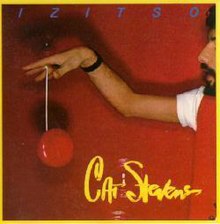Izitso
| Izitso | ||||
|---|---|---|---|---|
 |
||||
| Studio album by Cat Stevens | ||||
| Released | April 1977 | |||
| Recorded | 18 September 1976 – March 1977, Muscle Shoals Sound Studio, Sheffield, Alabama; Sound 80 Studios, Minneapolis; Ardent Studios, Memphis, Tennessee; Le Studio, Morin Heights, Quebec, Canada Sweet Silence Studios, Copenhagen, Denmark |
|||
| Genre | Soft rock, folk rock, blue-eyed soul, electronic rock, synthpop | |||
| Length | 35:55 | |||
| Label |
Island (UK/Europe) A&M (US/Canada) |
|||
| Producer |
Cat Stevens David Kershenbaum |
|||
| Cat Stevens chronology | ||||
|
||||
| Professional ratings | |
|---|---|
| Review scores | |
| Source | Rating |
| Allmusic | |
| Rolling Stone | Positive |
Izitso is the tenth studio album released by the British singer-songwriter Cat Stevens (now Yusuf Islam) in April 1977. After the lackluster Numbers, the album proved to be his comeback. The album updated the rhythmic folk rock and pop rock style of his earlier albums with the extensive use of synthesizers and other electronic music instruments, giving the album a more electronic rock and synthpop style, and anticipating elements of electro.
Upon its release, the music magazine Rolling Stone praised the album for blending together elements of folk rock and electronic music, "often in apparent opposition to each other", with "the diversity and the maturity to match this seeming incongruity." The album reached No. 7 on the American Pop Albums charts.
It also included his last US and UK top 40 chart hit for almost three decades, "(Remember the Days of the) Old Schoolyard", an early synthpop song that used a polyphonic synthesizer; it was a duet with fellow UK singer Elkie Brooks.Linda Lewis appears in the song's video, with Cat Stevens singing to her, as they portray former schoolmates, singing to each other on a schoolyard merry-go-round. (This is one of the few music videos that Stevens made, other than simple videos of concert performances.)
The song "Child for a Day" was featured in the 1977 film First Love, starring Susan Dey and William Katt.
The song "Was Dog a Doughnut?" upon release was criticised for sounding "a bit too robotlike" but has since been considered one of the first electro, or techno-pop, songs ever recorded, with elements later associated with hip hop music. The track made early use of a music sequencer along with synthesizers.
...
Wikipedia
